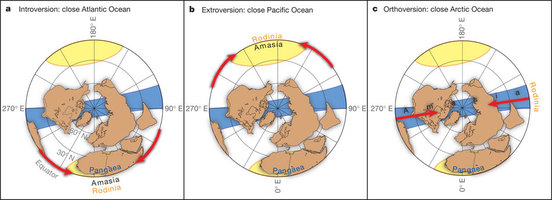Yale geology grad student Ross Mitchell and his team are examining a very slow process: the formation, disintegration, and reformation of Earth’s supercontinents. Pangea was the last supercontinent, and certainly the most famous. It formed 300 million years ago. But it wasn’t the first, and won’t be the last. Discover Magazine shares some of Mitchell’s work on describing the next one.
…the researchers first looked back beyond Pangaea and determined the location of supercontinents Rodinia, which formed about a billion years earlier, and Nuna, 700 million years before that. The team found that during the last two cycles, each supercontinent formed a quarter of the way around the globe from where the previous supercontinent had been. Using that insight, they calculated that Amasia will form over the North Pole.
Identifying precisely where the planet’s landmass has been and is going over the course of, say, a billion years, can be tricky. Mitchell’s team recently published findings in Nature magazine that shed light on one of the pieces of the puzzle: paleomagnetism.
Magnetic traces have long been used to calculate the latitudes, the north-south positions, of ancient continents. But longitude, the east-west position, is much trickier to pin down because Earth’s magnetic field varies little with longitude. To overcome the problem, Mitchell and his team devised a new way of analyzing the magnetic data to detect a phenomenon known as true polar wander—the gradual change in the position of Earth’s poles as the planet’s internal mass shifts. By tracking polar wander through time, the researchers were able to determine the longitudinal position of ancient rocks.
You can hear Ross Mitchell talk about his work on NPR’s Talk of the Nation here.
